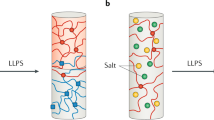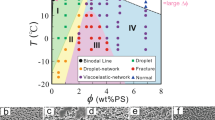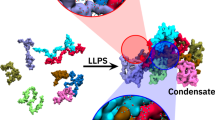Abstract
Many intracellular membraneless organelles form via phase separation of intrinsically disordered proteins (IDPs) or regions (IDRs). These include the Caenorhabditis elegans protein LAF-1, which forms P granule-like droplets in vitro. However, the role of protein disorder in phase separation and the macromolecular organization within droplets remain elusive. Here, we utilize a novel technique, ultrafast-scanning fluorescence correlation spectroscopy, to measure the molecular interactions and full coexistence curves (binodals), which quantify the protein concentration within LAF-1 droplets. The binodals of LAF-1 and its IDR display a number of unusual features, including ‘high concentration’ binodal arms that correspond to remarkably dilute droplets. We find that LAF-1 and other in vitro and intracellular droplets are characterized by an effective mesh size of ∼3–8 nm, which determines the size scale at which droplet properties impact molecular diffusion and permeability. These findings reveal how specific IDPs can phase separate to form permeable, low-density (semi-dilute) liquids, whose structural features are likely to strongly impact biological function.
This is a preview of subscription content, access via your institution
Access options
Access Nature and 54 other Nature Portfolio journals
Get Nature+, our best-value online-access subscription
$29.99 / 30 days
cancel any time
Subscribe to this journal
Receive 12 print issues and online access
$259.00 per year
only $21.58 per issue
Buy this article
- Purchase on Springer Link
- Instant access to full article PDF
Prices may be subject to local taxes which are calculated during checkout





Similar content being viewed by others
References
Brangwynne, C. P., Mitchison, T. J. & Hyman, A. A. Active liquid-like behavior of nucleoli determines their size and shape in Xenopus laevis oocytes. Proc. Natl Acad. Sci. USA 108, 4334–4339 (2011).
Sleeman, J. E. & Trinkle-Mulcahy, L. Nuclear bodies: new insights into assembly/dynamics and disease relevance. Curr. Opin. Cell Biol. 28, 76–83 (2014).
Han, T. W. et al. Cell-free formation of RNA granules bound RNAs identify features and components of cellular assemblies. Cell 149, 768–779 (2012).
Patel, A . et al. A liquid-to-solid phase transition of the ALS protein FUS accelerated by disease mutation. Cell 162, 1066–1077 (2015).
Brangwynne, C. P. et al. Germline P granules are liquid droplets that localize by controlled dissolution/condensation. Science 324, 1729–1732 (2009).
Lee, C. F., Brangwynne, C. P., Gharakhani, J., Hyman, A. A. & Juelicher, F. Spatial organization of the cell cytoplasm by position-dependent phase separation. Phys. Rev. Lett. 111, 088101 (2013).
Berry, J., Weber, S. C., Vaidya, N., Haataja, M. & Brangwynne, C. P. RNA transcription modulates phase transition-driven nuclear body assembly. Proc. Natl Acad. Sci. USA 112, E5237–E5245 (2015).
Brangwynne, C. P., Tompa, P. & Pappu, R. V. Polymer physics of intracellular phase transitions. Nat. Phys. 11, 899–904 (2015).
Li, P. et al. Phase transitions in the assembly of multivalent signalling proteins. Nature 483, 336–340 (2012).
Murakami, T . et al. Als/FTD mutation-induced phase transition of FUS liquid droplets and reversible hydrogels into irreversible hydrogels impairs RNP granule function. Neuron 88, 678–690 (2015).
Zhang, H. et al. RNA controls PolyQ protein phase transitions. Mol. Cell 60, 220–230 (2015).
Elbaum-Garfinkle, S. et al. The disordered P granule protein LAF-1 drives phase separation into droplets with tunable viscosity and dynamics. Proc. Natl Acad. Sci. USA 112, 7189–7194 (2015).
Lin, Y., Protter, D. S. W., Rosen, M. K. & Parker, R. Formation and maturation of phase-separated liquid droplets by RNA-binding proteins. Mol. Cell 60, 208–219 (2015).
Molliex, A . et al. Phase separation by low complexity domains promotes stress granule assembly and drives pathological fibrillization. Cell 163, 123–133 (2015).
Nott, T. J. et al. Phase transition of a disordered nuage protein generates environmentally responsive membraneless organelles. Mol. Cell 57, 936–947 (2015).
Altmeyer, M. et al. Liquid demixing of intrinsically disordered proteins is seeded by poly(ADP-ribose). Nat. Commun. 6, 8088 (2015).
Voronina, E., Seydoux, G., Sassone-Corsi, P. & Nagamori, I. RNA granules in germ cells. Cold Spring Harb. Perspect. Biol. 3, a002774 (2011).
Wang, J. T. et al. Regulation of RNA granule dynamics by phosphorylation of serine-rich, intrinsically-disordered proteins in C. elegans. eLife 3, e04591 (2014).
Saha, S . et al. Polar positioning of phase-separated liquid compartments in cells regulated by an mRNA competition mechanism. Cell 166, 1572–1584 (2016).
Feric, M . et al. Coexisting liquid phases underlie nucleolar subcompartments. Cell 165, 1686–1697 (2016).
Pak, C. W . et al. Sequence determinants of intracellular phase separation by complex coacervation of a disordered protein. Mol. Cell 63, 72–85 (2016).
Aumiller, W. M. Jr & Keating, C. D. Phosphorylation-mediated RNA/peptide complex coacervation as a model for intracellular liquid organelles. Nat. Chem. 8, 129–137 (2016).
Magde, D., Webb, W. W. & Elson, E. Thermodynamic fluctuations in a reacting system—measurement by fluorescence correlation spectroscopy. Phys. Rev. Lett. 29, 705–708 (1972).
Pitschke, M., Prior, R., Haupt, M. & Riesner, D. Detection of single amyloid beta-protein aggregates in the cerebrospinal fluid of Alzheimer's patients by fluorescence correlation spectroscopy. Nat. Med. 4, 832–834 (1998).
Ries, J. & Schwille, P. New concepts for fluorescence correlation spectroscopy on membranes. Phys. Chem. Chem. Phys. 10, 3487–3497 (2008).
Duocastella, M. & Arnold, C. B. Transient response in ultra-high speed liquid lenses. J. Phys. D 46, 075102 (2013).
Duocastella, M., Vicidomini, G. & Diaspro, A. Simultaneous multiplane confocal microscopy using acoustic tunable lenses. Opt. Express 22, 19293–19301 (2014).
Duocastella, M., Sun, B. & Arnold, C. B. Simultaneous imaging of multiple focal planes for three-dimensional microscopy using ultra-high-speed adaptive optics. J. Biomed. Opt. 17, 050505 (2012).
Mermillod-Blondin, A., McLeod, E. & Arnold, C. B. High-speed varifocal imaging with a tunable acoustic gradient index of refraction lens. Opt. Lett. 33, 2146–2148 (2008).
Taratuta, V. G., Holschbach, A., Thurston, G. M., Blankschtein, D. & Benedek, G. B. Liquid–liquid phase separation of aqueous lysozyme solutions: effects of pH and salt identity. J. Phys. Chem. 94, 2140–2144 (1990).
Broide, M. L., Berland, C. R., Pande, J., Ogun, O. O. & Benedek, GB. Binary-liquid phase separation of lens protein solutions. Proc. Natl Acad. Sci. USA 88, 5660–5664 (1991).
Rubinstein, M. & Colby, R. H. Polymer Physics (Oxford Univ. Press, 2003).
Huggins, M. L. Solutions of long chain compounds. J. Chem. Phys. 9, 440–440 (1941).
Flory, P. I. Thermodynamics of high polymer solutions. J. Chem. Phys. 10, 51–61 (1942).
Harding, S. E. & Johnson, P. The concentration-dependence of macromolecular parameters. Biochem. J. 231, 543–547 (1985).
Tirado-Miranda, M., Haro-Perez, C., Quesada-Perez, M., Callejas-Fernandez, J. & Hidalgo-Alvarez, R. Effective charges of colloidal particles obtained from collective diffusion experiments. J. Colloid. Interface Sci. 263, 74–79 (2003).
Simon, J. R., Carroll, N. J., Rubinstein, M., Chilkoti, A. & López, G. P. Programming molecular self-assembly of intrinsically disordered proteins containing sequences of low complexity. Nat. Chem. 9, 509–515 (2017).
Muthukumar, M. Thermodynamics of polymer solutions. J. Chem. Phys. 85, 4722–4728 (1986).
Cai, L.-H., Panyukov, S. & Rubinstein, M. Mobility of nonsticky nanoparticles in polymer liquids. Macromolecules 44, 7853–7863 (2011).
Updike, D. L., Hachey, S. J., Kreher, J . & Strome, S. P granules extend the nuclear pore complex environment in the C. elegans germ line. J. Cell Biol. 192, 939–948 (2011).
Handwerger, K. E., Cordero, J. A. & Gall, J. G. Cajal bodies, nucleoli, and speckles in the Xenopus oocyte nucleus have a low-density, sponge-like structure. Mol. Biol. Cell 16, 202–211 (2005).
Updike, D. & Strome, S. P granule assembly and function in Caenorhabditis elegans germ cells. J. Androl. 31, 53–60 (2010).
Frey, S. & Görlich, D. A saturated FG-repeat hydrogel can reproduce the permeability properties of nuclear pore complexes. Cell 130, 512–523 (2007).
Nott, T. J., Craggs, T. D. & Baldwin, A. J. Membraneless organelles can melt nucleic acid duplexes and act as biomolecular filters. Nat. Chem. 8, 569–575 (2016).
Skinner, J. P., Chen, Y. & Muller, J. D. Position-sensitive scanning fluorescence correlation spectroscopy. Biophys. J. 89, 1288–1301 (2005).
Vitalis, A. & Pappu, R. V. Absinth: a new continuum solvation model for simulations of polypeptides in aqueous solutions. J. Comput. Chem. 30, 673–699 (2009).
Das, R. K., Ruff, K. M. & Pappu, R. V. Relating sequence encoded information to form and function of intrinsically disordered proteins. Curr. Opin. Struct. Biol. 32, 102–112 (2015).
Acknowledgements
We thank H. Zhang and D. M. Mitrea for purifying WHI3 and NPM1, respectively. We acknowledge funding from the Princeton Center for Complex Materials, an MRSEC supported by NSF grant DMR 1420541, and the Eric and Wendy Schmidt Transformative Technology Fund. This work was also supported by an NIH Director's New Innovator Award (1DP2GM105437-01 to C.P.B.), an NSF CAREER award (1253035 to C.P.B.), NIH grants (1K99NS096217-01 to S.E.G. and 5RO1NS056114 to R.V.P.), and an HFSP Program grant (RGP0007/2012 to C.P.B.). A.S.H. is a Bonnie and Kent Lattig graduate fellow in the Center for Biological Systems Engineering at Washington University in Saint Louis. We thank C. Theriault from TAG Optics for providing the TAG lens used in this study.
Author information
Authors and Affiliations
Contributions
M.W. acquired and analysed data in usFCS development and nano-scale rheology. S.E.G. acquired and analysed data in particle tracking microrheology, FCS and dextran permeability. A.S.H. performed computational simulations and theoretical analysis. C.C.C. created in vivo LAF-1 constructs and injected dextran molecules into C. elegans. M.F. created in vivo NPM1/FIB-1 constructs and injected dextran molecules into X. laevis. M.W., C.B.A., C.P.B. and R.D.P. designed the usFCS measurements. A.S.H. and R.V.P. designed the theoretical analysis with input from M.W., S.E.G. and C.P.B.; M.W., S.E.G. A.S.H., R.V.P. and C.P.B. wrote the paper.
Corresponding authors
Ethics declarations
Competing interests
The authors declare no competing financial interests.
Supplementary information
Rights and permissions
About this article
Cite this article
Wei, MT., Elbaum-Garfinkle, S., Holehouse, A. et al. Phase behaviour of disordered proteins underlying low density and high permeability of liquid organelles. Nature Chem 9, 1118–1125 (2017). https://doi.org/10.1038/nchem.2803
Received:
Accepted:
Published:
Issue Date:
DOI: https://doi.org/10.1038/nchem.2803
This article is cited by
-
High-throughput and proteome-wide discovery of endogenous biomolecular condensates
Nature Chemistry (2024)
-
Sequence-dependent material properties of biomolecular condensates and their relation to dilute phase conformations
Nature Communications (2024)
-
Rational design of phase separating peptides based on phase separating protein sequence of p53
Scientific Reports (2023)
-
Phase-separating pyrenoid proteins form complexes in the dilute phase
Communications Biology (2023)
-
Vacuole dynamics and popping-based motility in liquid droplets of DNA
Nature Communications (2023)



